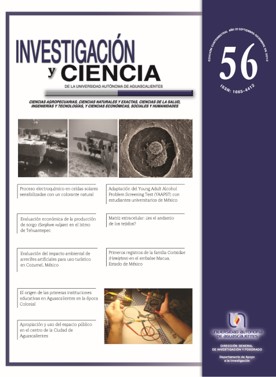Proceso electroquímico en celdas solares sensibilizadas con un colorante natural
DOI:
https://doi.org/10.33064/iycuaa2012564023Palabras clave:
imitar, celda solar, colorante, fotosíntesis, plantas, energíaResumen
Para aprender de la naturaleza en lo que respecta a uno de los fenómenos más antiguos que han ocurrido en la faz de la Tierra, como lo es la fotosíntesis, es que investigadores han desarrollado modelos que imitan los procesos de absorción de
luz solar realizada por las plantas verdes. En este trabajo se describe la construcción de una celda solar cuyo funcionamiento trata de imitar la manera de captar la energía solar tal y como lo hacen las plantas. De acuerdo con los resultados obtenidos en la construcción de la celda solar y las respuestas eléctricas generadas en las mediciones de sus propiedades fotoelectroquímicas,
se puede concluir que estas celdas imitan a la fotosíntesis natural de las plantas verdes en cuanto a su proceso de absorción de la luz y transferencia de electrones en donde ambos procesos se realizan por separado.
Descargas
Métricas
Citas
• ABALOS, C. et al., Comportamiento de la intensidad de la luz de las lámparas halógenas y leds a través de la resina compuesta. Dentum, 5(3): 102-106, 2005.
• ANDÚJAR, J.M.; DURÁN, E.; PILIOUGINE, M.; SIDRACH DE CARDONA, M.; GALÁN, J., Different Methods to Obtain the I-V Curve of PV Modules: A Review. In: Proceedings of the 33rd IEEE PVSC. San Diego, CA, 2008.
• BISQUERT, J.; CAHEN, D.; HODES, G.; RÜHLE, S.; ZABAN, A., Physical Chemical Principles of Photovoltaic Conversion with Nanoparticulate, Mesoporous Dye-Sensitized Solar Cells. J. Phys. Chem. B., 108: 24-29, 2004.
• BLANKENSHIP, R.E., Molecular Mechanisms of Photosynthesis. England: Blackwell Science, 2002.
• BUCHNER, T.B.; EWINGEN, N.H., Photosynthesis: Theory and Applications in Energy, Biotechnology and Nanotechnology. USA: Nova Science Publishers, 2009.
• CHANDRA, S; PANDEY, R.K., Semiconductor Photoelectrochemical Solar Cells. Physical State Solid (a), 72: 415-454, 1982.
• COLLINGS, A.; CRITCHLEY, C., Artificial Photosynthesis: From Basic Biology to Industrial Applications. USA: Wiley-VCH, 2005.
• GERNOT, R., Primary Processes of Photosynthesis: Principles and Apparatus. RSC Publishing, 9: 61-63, 2008.
• GESSERT, T., COUTTS, T., DUDA, A., DHERE, R., JOHNSTON,S., LEVI, D., NREL National Center for Photovoltaics and Solar Program, Denver, Colorado: Review Meeting;2003.
• GRAETZEL, M., Energy Resources Through Photochemistry and Catalysis, USA, Academic Press, 1983.
• HAGFELDT, A.d GRAETZEL, M., Light-Induced Redox Reactions in Nanocrystalline Systems, Chemica, Reviews, 95 1), 1995.
• HALME, J., Dye-Sensitized Nanostructured and Organic Photovoltaic Cells: Master’s thesis, Finland: Helsinky University of Technology, Department of Engineering Physics and Mathematics. 2002.
• KALYANASUNDARAM, K., KIWI, J.& GRAETZEL, M., Structure Bonding, Berlin Vol. 49, 30-36, 1982.
• LEWIS, N S., Global Energy Perspective, USA, CaliforniaInstitute of Technology, Division of Chemistry, 2004.
• LEWIS, N S.: New Directions and Challenges in Electrochemistry: Frontiers of Research in Photoelectrochemical Solar Energy Conversion, Journal of Electroanalytical Chemistry, 508, 1-10, 2001.
• MAO, D., KIM, K.d FRANK A., Open Circuit Photovoltage and Charge Recombination at Semiconductor /Liquid Interfaces, Electrochemical Society. 141, 1231-1236, 1994.
• MEISSNER, D., Solar Technology - Photoelectrochemical Solar Energy Conversion, In: Ullmann’s Encyclopedia of Industrial Chemistry, German : Electronic Release, 1999.
• MOHAMMAD, P., Handbook of Photosynthesis, USA, CRC Press Taylor & Francis Group, 2005.
• NOZIK, A Jd; ARCHER, M D., Photochemical and Photoelectrochemical Approaches to Solar Energy Conversion. World Scientific Pub Co Inc., 3, 760, 2008.
• OREGAN, B.d GRAETZEL, M., A Low-Cost High-Efficiency Solar Cell Based on Dye-Sensitized Colloidal TiO2 Films, Nature, 353, 63-46, 1991.
• OXTOBY, D W., GILLIS, H P.d NACHTRIEB, N H., Principles of Modern Chemistry, Thomson/Brooks/Cole, 1104, 2005.
• SEKAR, N., GEHOT V., Metal Complex Dyes for Dye-Sensitized Solar Cells: Recent Developments, India: Institute of Chemical Technology, 2010.
• SMESTAD, G P.d GRAETZEL, M., Demonstrating Electron Transfer and Nanotechnology: A Natural Dye-Sensitized Nanocrystalline Energy Converter, Journal Chemical Education, 75, 752, 1998.
• XIAO, Z., LI, M., XU, M.; LU, Z., Journal of Physics and Chemistry of Solids, 59, 911-914, 1998.
• ZWEIBEL, K., Solar Power: The Photovoltaics Challenge, USA, Plenu3, 1990.
• ZWEIBEL, K., Thin-Film Photovoltaic Cells. American Scientist, 81, 362-369, 1993.Dictiotopografía
• OUTTASIGHT, J., Fibonacci Pattern Solar Arrays, Navitron Renewable Energy and Sustainability Forum. Disponible en http://www.amnh.org/nationalcenter/youngnaturalistawards/2011/aidan.html, (14 de febrero de2012).
Descargas
Publicado
Cómo citar
Licencia
Derechos de autor 2012 Pablo César Carbó Vela, Enrique Rocha Rangel

Esta obra está bajo una licencia internacional Creative Commons Atribución-NoComercial-CompartirIgual 4.0.
Las obras publicadas en versión electrónica de la revista están bajo la licencia Creative Commons Atribución-NoComercial-CompartirIgual 4.0 Internacional (CC BY-NC-SA 4.0)









